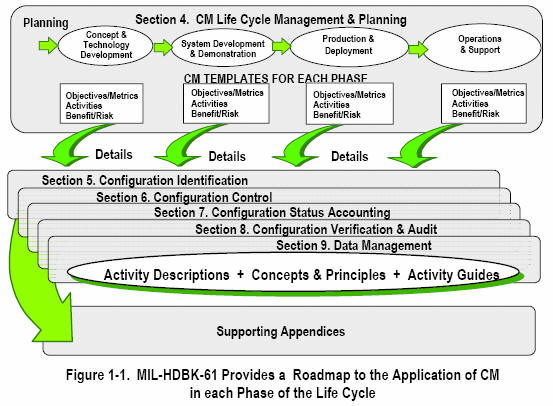MIL-HDBK-61A: Scope
< Previous | Contents | Next >
1.2 Application of CM over the Program Life Cycle Phases
Figure 1-1 illustrates how this military handbook's content is structured to provide a comprehensive guide (roadmap) to the application of configuration management through all life cycle phases of a program. As defined in DoD Instruction 5000.2 and DoD Regulation 5000.2-R, the life cycle extends from concept studies through demilitarization and disposal. A given military program however may not include all of the phases. Following Section 1 "Scope," Section 2 "Applicable Documents," and Section 3 "Definitions," the handbook is divided into the following major sections:
a. Section 4. CM Life Cycle Management and Planning.
Since management and planning are the keys to effective implementation of CM, Section 2 provides the focus for the entire handbook. It contains an overview of the CM process, a discussion of CM's relationships to other processes, and a synopsis of Government/contractor configuration management during the entire program life cycle. It addresses global CM Management activities applicable to all phases such as planning, process implementation, and performance measurement. A series of templates [Tables 4-1 through 4-4] address the following for each life cycle phase:
-
CM Objectives keyed to the program objectives for the Phase [Figure 4-5]
-
CM Activities supporting those objectives
-
Benefits and risks
-
Metrics to assess achievement of objectives and foster process improvement
-
Key actions to be taken, interfaces to be established and information needed to perform the activities
-
Pointers and references to specific supporting details found in Sections 2 through 7 and Appendices.
b. Sections 5 through 9. Major CM Functions.
In support of Section 2, Sections 3 through 7 contain detailed information in the form of activity descriptions, activity models, principles and concepts, and activity guides (diagrams, checklists, tables, etc.) for the following topics:
-
Section 5 Configuration Identification
-
Section 6 Configuration Control
-
Section 7 Configuration Status Accounting
-
Section 8. Configuration Verification and Audit
-
Section 9. Data Management
c. Appendices
The appendices to this handbook consist of additional information, supporting either the planning and information timeline in Section 4 or the details in Sections 5 through 9.

For correct application of this information, see NOTE on Contents page